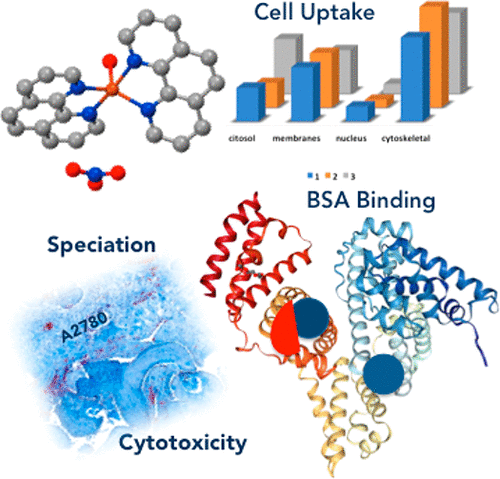当前位置:
X-MOL 学术
›
Inorg. Chem.
›
论文详情
Our official English website, www.x-mol.net, welcomes your feedback! (Note: you will need to create a separate account there.)
Copper Complexes with 1,10-Phenanthroline Derivatives: Underlying Factors Affecting Their Cytotoxicity.
Inorganic Chemistry ( IF 4.6 ) Pub Date : 2020-06-24 , DOI: 10.1021/acs.inorgchem.0c00925 Patrique Nunes 1 , Isabel Correia 1 , Fernanda Marques 2 , António Pedro Matos 3 , Margarida M C Dos Santos 1 , Cristina G Azevedo 1 , José-Luis Capelo 4, 5 , Hugo M Santos 4, 5 , Sofia Gama 6 , Teresa Pinheiro 7 , Isabel Cavaco 1, 8 , João Costa Pessoa 1
Inorganic Chemistry ( IF 4.6 ) Pub Date : 2020-06-24 , DOI: 10.1021/acs.inorgchem.0c00925 Patrique Nunes 1 , Isabel Correia 1 , Fernanda Marques 2 , António Pedro Matos 3 , Margarida M C Dos Santos 1 , Cristina G Azevedo 1 , José-Luis Capelo 4, 5 , Hugo M Santos 4, 5 , Sofia Gama 6 , Teresa Pinheiro 7 , Isabel Cavaco 1, 8 , João Costa Pessoa 1
Affiliation

|
The interpretation of in vitro cytotoxicity data of Cu(II)-1,10-phenanthroline (phen) complexes normally does not take into account the speciation that complexes undergo in cell incubation media and its implications in cellular uptake and mechanisms of action. We synthesize and test the activity of several distinct Cu(II)-phen compounds; up to 24 h of incubation, the cytotoxic activity differs for the Cu complexes and the corresponding free ligands, but for longer incubation times (e.g., 72 h), all compounds display similar activity. Combining the use of several spectroscopic, spectrometric, and electrochemical techniques, the speciation of Cu-phen compounds in cell incubation media is evaluated, indicating that the originally added complex almost totally decomposed and that Cu(II) and phen are mainly bound to bovine serum albumin. Several methods are used to disclose relationships between structure, activity, speciation in incubation media, cellular uptake, distribution of Cu in cells, and cytotoxicity. Contrary to what is reported in most studies, we conclude that interaction with cell components and cell death involves the separate action of Cu ions and phen molecules, not [Cu(phen)n] species. This conclusion should similarly apply to many other Cu-ligand systems reported to date.
中文翻译:

具有1,10-菲咯啉衍生物的铜配合物:影响其细胞毒性的潜在因素。
Cu(II)-1,10-菲咯啉(phen)配合物的体外细胞毒性数据的解释通常没有考虑到配合物在细胞培养介质中经历的形态及其对细胞摄取和作用机制的影响。我们合成并测试了几种不同的Cu(II)-phen化合物的活性;在长达24小时的孵育过程中,对于铜配合物和相应的游离配体,其细胞毒性活性有所不同,但是孵育时间更长(例如,,72小时),所有化合物显示相似的活性。结合使用几种光谱学,光谱学和电化学技术,对细胞培养介质中Cu-phen化合物的形态进行了评估,表明最初添加的复合物几乎完全分解,并且Cu(II)和phen主要与牛血清结合白蛋白。几种方法用于揭示结构,活性,孵育培养基的形态,细胞摄取,细胞中Cu的分布和细胞毒性之间的关系。与大多数研究报道的相反,我们得出的结论是,与细胞组分的相互作用和细胞死亡涉及Cu离子和phen分子(而不是[Cu(phen)n ] )的单独作用。该结论应类似地适用于迄今为止报道的许多其他铜配体系统。
更新日期:2020-07-06
中文翻译:

具有1,10-菲咯啉衍生物的铜配合物:影响其细胞毒性的潜在因素。
Cu(II)-1,10-菲咯啉(phen)配合物的体外细胞毒性数据的解释通常没有考虑到配合物在细胞培养介质中经历的形态及其对细胞摄取和作用机制的影响。我们合成并测试了几种不同的Cu(II)-phen化合物的活性;在长达24小时的孵育过程中,对于铜配合物和相应的游离配体,其细胞毒性活性有所不同,但是孵育时间更长(例如,,72小时),所有化合物显示相似的活性。结合使用几种光谱学,光谱学和电化学技术,对细胞培养介质中Cu-phen化合物的形态进行了评估,表明最初添加的复合物几乎完全分解,并且Cu(II)和phen主要与牛血清结合白蛋白。几种方法用于揭示结构,活性,孵育培养基的形态,细胞摄取,细胞中Cu的分布和细胞毒性之间的关系。与大多数研究报道的相反,我们得出的结论是,与细胞组分的相互作用和细胞死亡涉及Cu离子和phen分子(而不是[Cu(phen)n ] )的单独作用。该结论应类似地适用于迄今为止报道的许多其他铜配体系统。



























 京公网安备 11010802027423号
京公网安备 11010802027423号